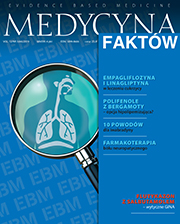Jak wdrażać i stosować linagliptynę? Artykuł przeglądowy
##plugins.themes.bootstrap3.article.main##
Abstrakt
Podstawowym lekiem doustnym w terapii cukrzycy typu 2 jest metformina, niestety w ponad połowie przypadków monoterapia metforminą po 3 latach okazuje się niewystarczająca. Częstym krokiem jest wtedy dołączenie do terapii pochodnej sulfonylomocznika. Lepszym rozwiązaniem, pozbawionym działań niepożądanych, w tym ryzyka hipoglikemii i przyrostu masy ciała, możliwym do zastosowania także w przypadku chorych z niewydolnością nerek i wątroby, jest włączenie linagliptyny. Artykuł omawia najważniejsze badania potwierdzające zalety linagliptyny.
##plugins.themes.bootstrap3.article.details##
Jak cytować
Sapilak, B. J., & Mastalerz-Migas, A. (2019). Jak wdrażać i stosować linagliptynę? . Medycyna Faktów , 12(3(44), 258-260. https://doi.org/10.24292/01.MF.0319.12
Numer
Dział
Artykuły
Copyright © by Medical Education. All rights reserved.
Bibliografia
1. Heise T., Graefe-Mody E.U., Hüttner S. et al.: Pharmacokinetics, pharmacodynamics and tolerability of multiple oral doses of linagliptin, a dipeptidyl peptidase-4 inhibitor in male type 2 diabetes patients. Diabetes Obes. Metab. 2009; 11: 786-794.
2. Del Prato S., Barnett A.H., Huisman H. et al.: Effect of linagliptin monotherapy on glycaemic control and markers of b-cell function in patients with inadequately controlled type 2 diabetes: a randomised controlled trial. Diabetes Obes. Metab. 2011; 13: 258-267.
3. Kawamori R., Inagaki N., Araki E. et al.: Linagliptin monotherapy improves glycemic control in Japanese patients with T2DM over 12 weeks [poster no. 0696-P]. 70th Annual Scientific Sessions of the ADA; 2010 Jun 25–29; Orlando (FL).
4. Lewin A.J., Arvay L., Liu D. et al.: Safety and efficacy of linagliptin as add-on therapy to a sulphonylurea in inadequately controlled type 2 diabetes (abstract no. 821). 46th Annual Meeting of the EASD; 2010 Sep 20–24; Stockholm.
5. Gallwitz B., Rosenstock J., Emser A. et al.: Linagliptin is more effective than glimepiride at achieving a composite outcome of A1c target with no hypoglycaemia and no weight gain over 2 years in mildly hyperglycaemic T2D pts on metformin [abstract no. 1044-P]. 72nd Scientific Sessions of the American Diabetes Association; 2012 Jun 8–12; Philadelphia (PA).
6. Del Prato S., Taskinen M.R., Owens D.R. et al.: Efficacy and safety of linagliptin in subjects with type 2 diabetes mellitus and poor glycemic control: pooled analysis of data from three placebo-controlled phase III trials. J. Diabetes Complications 2013; 27(3): 274-279. DOI: 10.1016/j.jdiacomp.2012.11.008.
7. Owens D.R., Swallow R., Dugi K.A. et al.: Efficacy and safety of linagliptin in persons type 2 diabetes inadequately controlled by a combination of metformin and type sulphonylurea: a 24-week randomised study. Diabetic Med. 2011; 28: 1352-1361.
8. Gallwitz B., Uhlig-Laske B., Bhattacharaya S. et al.: Linagliptin has similar efficacy to glimepiride but improved cardiovascular safety over 2 years in patients with type 2 diabetes inadequately controlled on metformin. 71th Scientific Sessions of the American Diabetes Association. San Diego, California, 2011; poster 39-LB.
9. Marx N., Rosenstock J., Kahn S.E. et al.: Design and baseline characteristics of the CARdiovascular Outcome Trial of LINAgliptin Versus Glimepiride in Type 2 Diabetes (CAROLINA®). Diab. Vasc. Dis. Res. 2015; 12(3): 164-174. DOI: 10.1177/1479164115570301.
10. McGuire D.K., Alexander J.H., Johansen O.E. et al.: Linagliptin Effects on Heart Failure and Related Outcomes in Individuals With Type 2 Diabetes Mellitus at High Cardiovascular and Renal Risk in CARMELINA. Circulation 2019; 139(3): 351-361. DOI: 10.1161/CIRCULATIONAHA.118.038352.
2. Del Prato S., Barnett A.H., Huisman H. et al.: Effect of linagliptin monotherapy on glycaemic control and markers of b-cell function in patients with inadequately controlled type 2 diabetes: a randomised controlled trial. Diabetes Obes. Metab. 2011; 13: 258-267.
3. Kawamori R., Inagaki N., Araki E. et al.: Linagliptin monotherapy improves glycemic control in Japanese patients with T2DM over 12 weeks [poster no. 0696-P]. 70th Annual Scientific Sessions of the ADA; 2010 Jun 25–29; Orlando (FL).
4. Lewin A.J., Arvay L., Liu D. et al.: Safety and efficacy of linagliptin as add-on therapy to a sulphonylurea in inadequately controlled type 2 diabetes (abstract no. 821). 46th Annual Meeting of the EASD; 2010 Sep 20–24; Stockholm.
5. Gallwitz B., Rosenstock J., Emser A. et al.: Linagliptin is more effective than glimepiride at achieving a composite outcome of A1c target with no hypoglycaemia and no weight gain over 2 years in mildly hyperglycaemic T2D pts on metformin [abstract no. 1044-P]. 72nd Scientific Sessions of the American Diabetes Association; 2012 Jun 8–12; Philadelphia (PA).
6. Del Prato S., Taskinen M.R., Owens D.R. et al.: Efficacy and safety of linagliptin in subjects with type 2 diabetes mellitus and poor glycemic control: pooled analysis of data from three placebo-controlled phase III trials. J. Diabetes Complications 2013; 27(3): 274-279. DOI: 10.1016/j.jdiacomp.2012.11.008.
7. Owens D.R., Swallow R., Dugi K.A. et al.: Efficacy and safety of linagliptin in persons type 2 diabetes inadequately controlled by a combination of metformin and type sulphonylurea: a 24-week randomised study. Diabetic Med. 2011; 28: 1352-1361.
8. Gallwitz B., Uhlig-Laske B., Bhattacharaya S. et al.: Linagliptin has similar efficacy to glimepiride but improved cardiovascular safety over 2 years in patients with type 2 diabetes inadequately controlled on metformin. 71th Scientific Sessions of the American Diabetes Association. San Diego, California, 2011; poster 39-LB.
9. Marx N., Rosenstock J., Kahn S.E. et al.: Design and baseline characteristics of the CARdiovascular Outcome Trial of LINAgliptin Versus Glimepiride in Type 2 Diabetes (CAROLINA®). Diab. Vasc. Dis. Res. 2015; 12(3): 164-174. DOI: 10.1177/1479164115570301.
10. McGuire D.K., Alexander J.H., Johansen O.E. et al.: Linagliptin Effects on Heart Failure and Related Outcomes in Individuals With Type 2 Diabetes Mellitus at High Cardiovascular and Renal Risk in CARMELINA. Circulation 2019; 139(3): 351-361. DOI: 10.1161/CIRCULATIONAHA.118.038352.
